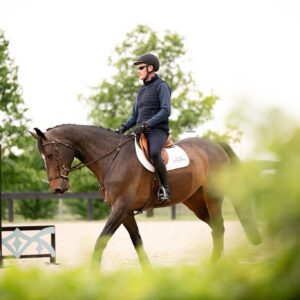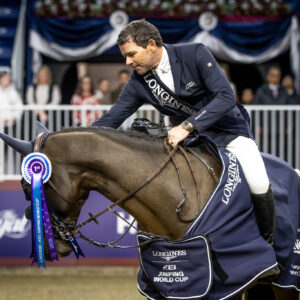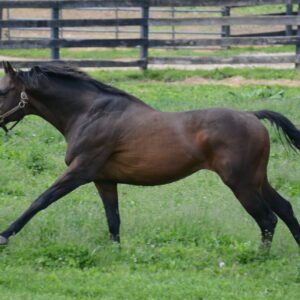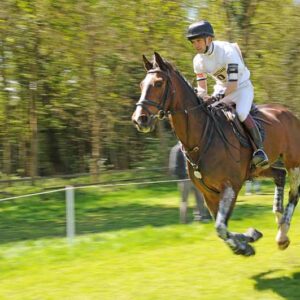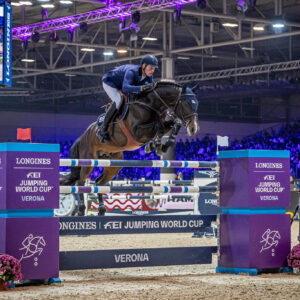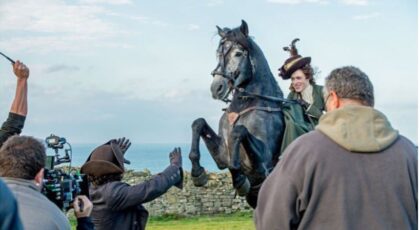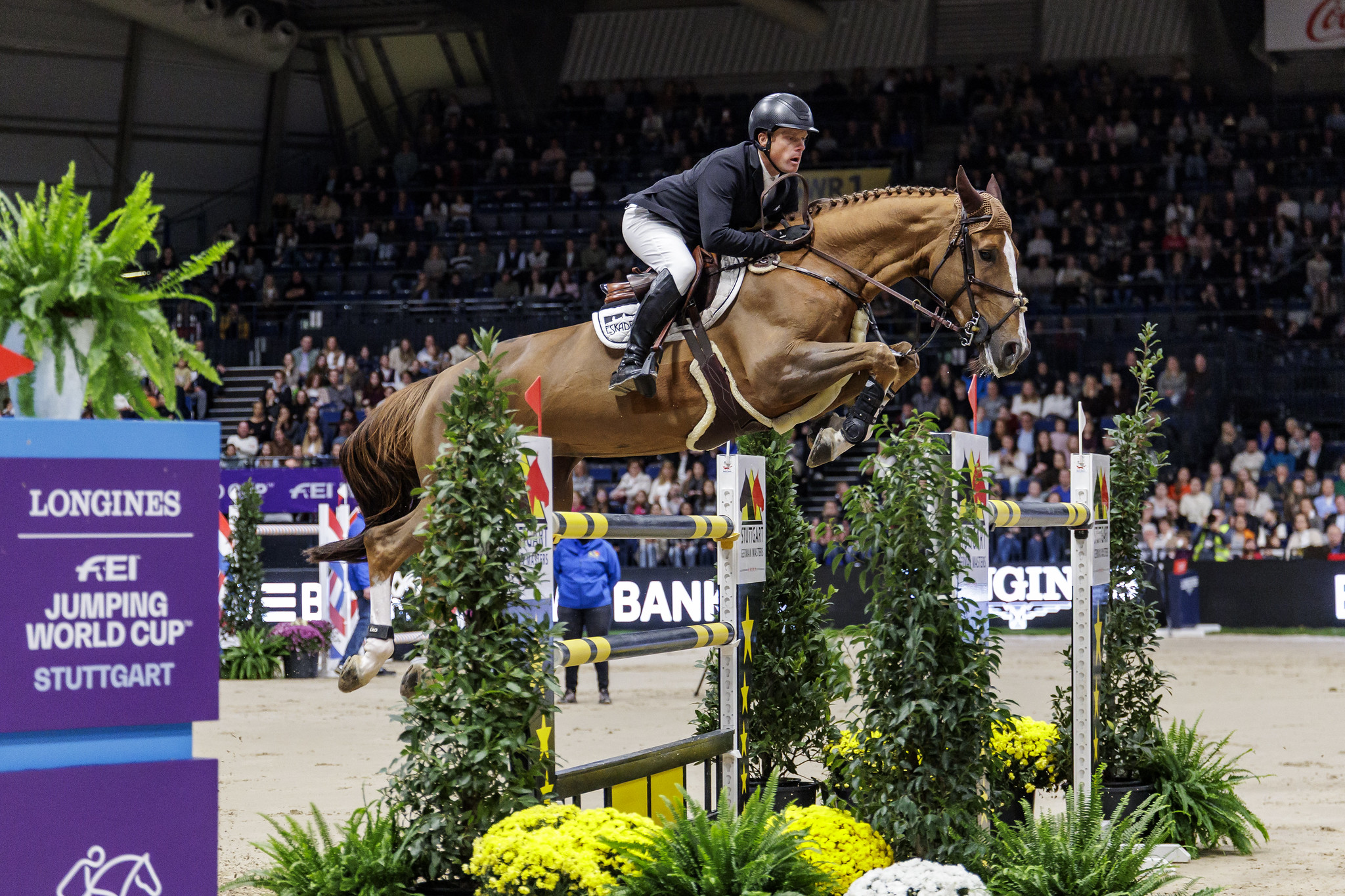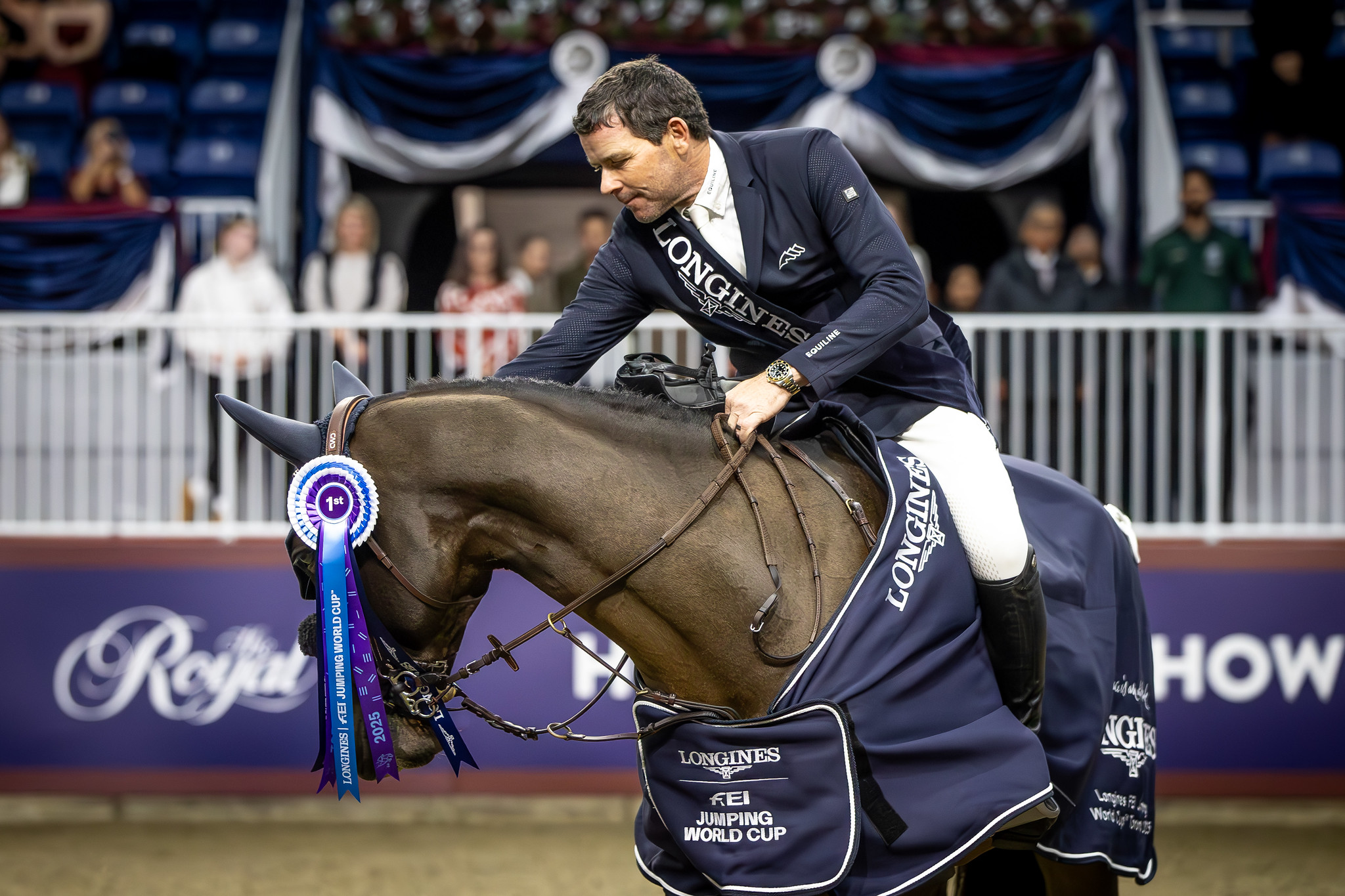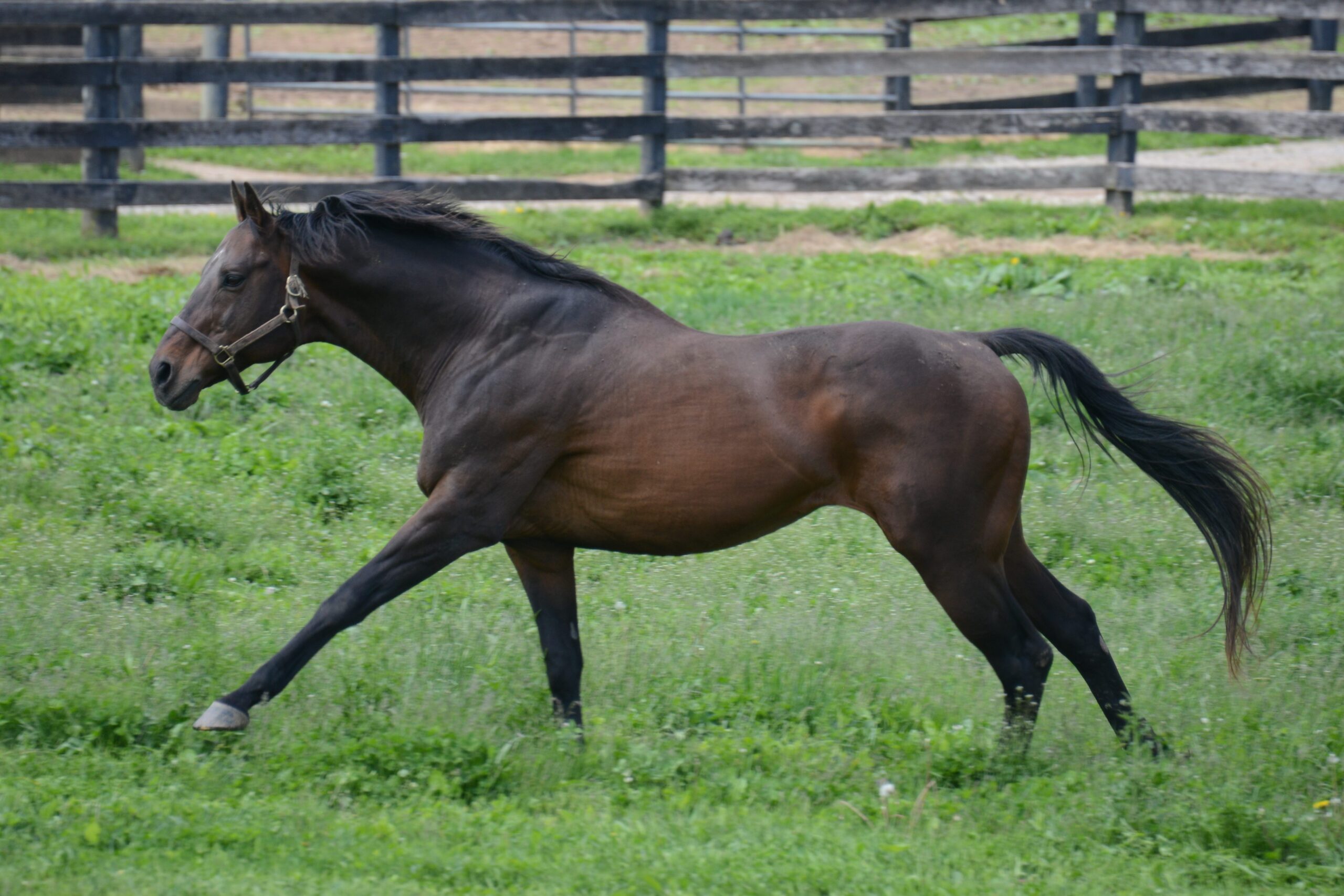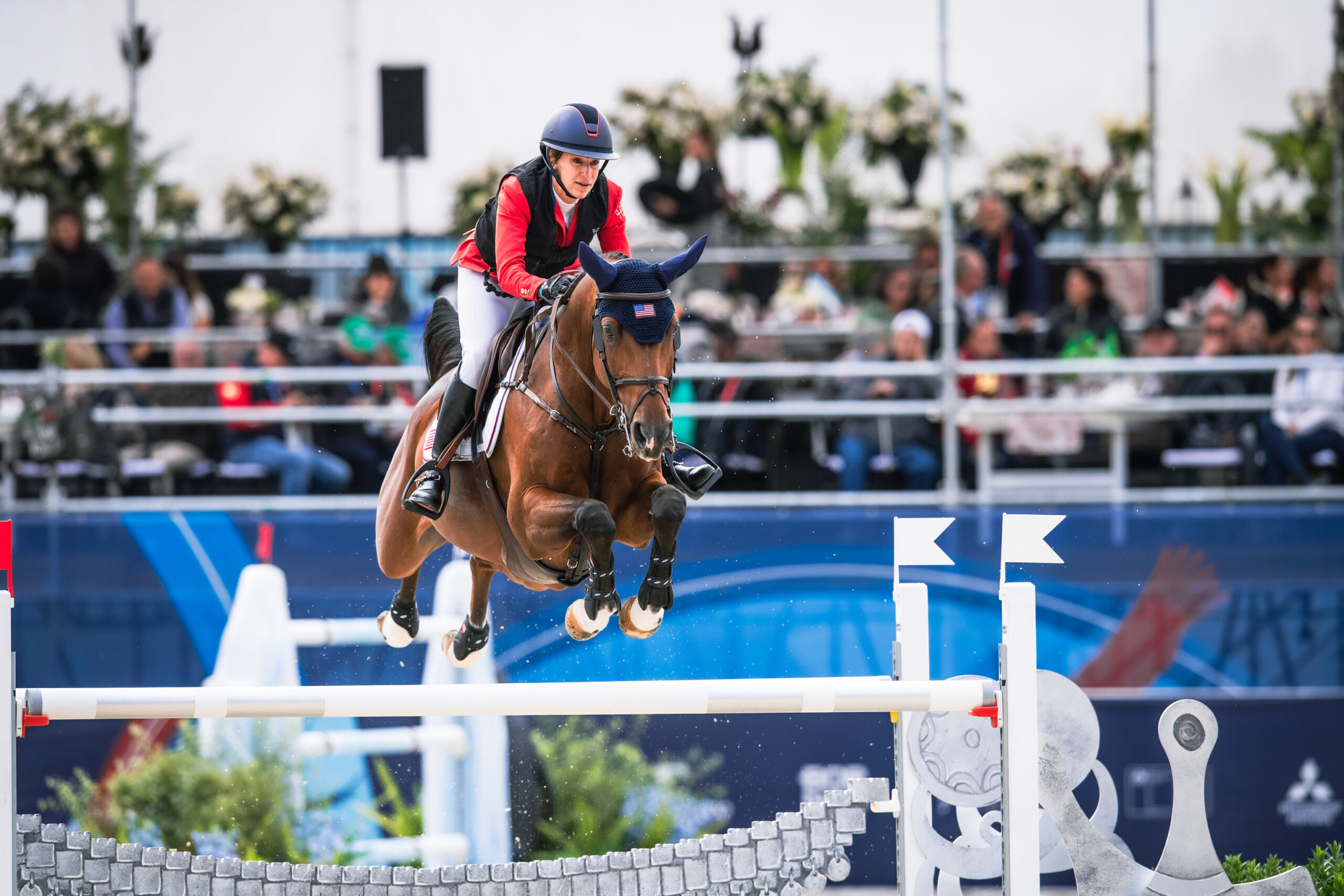I’ve ridden horses for most of my life. Often times, it’s been young horses, and because of that it’s become a habit to be aware of the details that are going on around me. Especially at horse shows, because you never know what can happen.
There are unexpected sounds—a motorbike passing by, or a flag snapping in the wind.
Even when you’ve been doing this professionally for many decades, like I have, and even when you are well-prepared with your horses, and take all the precautions, the unexpected can still occur.
On May 17, 2023, I was just a couple of months into a new job working for Nicki Shahinian Simpson and Riffle Hitch Stables, where it was basically my role to prepare the FEI horses for the students. We were in Lexington, Kentucky, on a Wednesday at the horse show, and I’d already flatted two or three horses that morning. We’d also shown a few horses in the Young Horse classes and some others.
At about 10:30 a.m., I headed to the FEI warm-up ring, near the Rolex Arena, to ride one of the mares who would be competing a few hours later with one of our students. I’d been riding her for the last two or three months that I’d been hired, so I knew her fairly well by that point.
She was very sensitive, and I was used to taking extra time and precautions when working with her. For instance, she had a hard time with the travel involved to horse shows, and also with her girth, so we would always walk her and put the girth up very slowly, one hole at a time.
Her biggest thing was that when you rode her, you couldn’t get on using a mounting block, so our team had system for giving me a leg-up. At 10:51 a.m.—a time that will stay with me forever—I was getting ready to mount her, and we were along the edge of FEI schooling ring, near the bushes and the fence line.
The groom gave me a leg-up, the same way we did every day. But before I had even touched the saddle, or had a hold of the reins, the mare suddenly bucked, hard. She sent me flying into the air, and as I fell, I landed between the horse and the fence, and my right leg hit the middle fence board on the way down.
I think I very quickly went into shock at that point, so the details are still hazy. I have to rely on other people who were around me for what happened next.
I know I was there on the ground—I never passed out—so I was awake and aware. But I wasn’t feeling any pain, even though I really should have been.
I would learn later I’d suffered a compound, open pilon fracture of my right tibia, which basically exploded my ankle. The people around me could see that my bone had actually gone through my skin, and perforated through the double-leather of my riding boot.
Nicki was up there at the ring with me, and I was hugging her legs and screaming. They told me after they could hear me screaming across the warm-up to the other side of the horse show. It was strange, though, because I wasn’t screaming in pain.
The doctors told me later that with a major injury like mine, the body often shuts your pain sensors down immediately, so you don’t feel the injury. Although they had called the ambulance right away, it was late, so I ended up being down on the ground in the FEI warm-up area for almost 40 minutes.
Finally, I heard the sound of the ambulance sirens, and the EMTS arrived to take me to the University of Kentucky’s UK ER. They were immediately concerned about the possibility of infection in my leg, given how long I’d been down on the sand.
I still wasn’t feeling pain when we got to the ER, and I was angry and confused in the hospital, when the medical staff began to cut off my clothing. I saw this huge pair of scissors, and I realized they were cutting off a brand-new pair of breeches, and my Parlanti boots.
I was almost more upset about that than the actual injury at the time, because I still wasn’t grasping how serious it really was. But it was bad. Two years later, the people who know me and were there tell me not to look at the pictures that were taken of my leg in the ER.
They say I don’t want to see it, even now, so I haven’t looked.
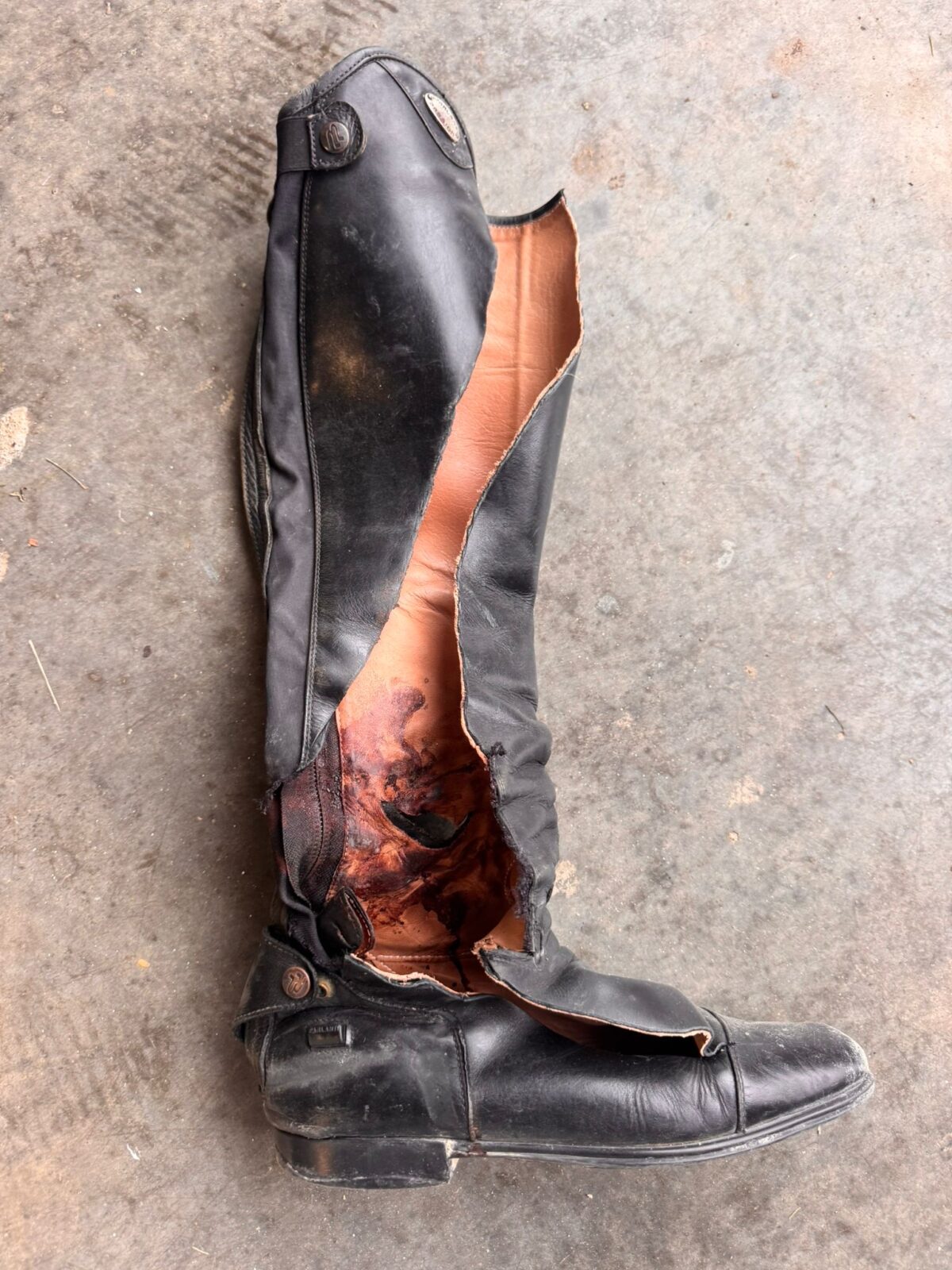
The ER doctors must have checked to make sure I hadn’t injured anything else in my body, and after that, they moved me to the Intensive Care Unit.
As a rider, I’ve fallen off many times in my career, and I’ve had to go to the hospital for a couple of them. Once, I had to have a surgery on my right humerus bone after a fall. But as the day wore on, I was realizing those other times were nothing like this.
The doctors who treated me were kind, competent, and accommodating. They were smiling, and trying to be positive, but I could feel there was something in the air.
The next four days in Intensive Care were a blur. There was no question that I needed surgery, but I was totally confined to my bed and on heavy pain and antibiotic medications while the doctors were deciding how to proceed. I couldn’t get up to use the restroom. It was just a very hard and frightening time.
When I was at last able to have surgery, they put an external fixator on my leg to stabilize my break. That’s a device that attaches to the bones inside your leg with pins and wires, but it is connected to a frame that is built around the leg on the outside.
When I woke up, I remember it was very strange to see my leg in that. But what I really remember feeling at the time was anger.
For someone like me, who rides and trains for a living, I need my legs to move—to ride horses and walk courses with students. It’s how I earn my living, so I was immediately very concerned. Mostly, I worried about who would take care of my mother in Northern Italy.
They told me later that when I was on the ground, right after my injury, one of the things I was yelling was, “Who is going to help my mother? Who is going to help my family now?”
I don’t remember doing it, but it makes sense. I’m alone over here, and my family—even though they are far away—is everything to me. I had been helping to support my mother and sister from over here, and I was immediately fearful about what this injury would mean for them, too.
Thankfully, they never knew how bad it really was. Even today, my family probably only knows 50 percent of what really happened to me.
I called them once before my first surgery, because I knew I was going to be under anesthesia. I minimized the surgery I was having, and told them it was just a regular fracture, but that because they were putting me under, I was calling them “just in case.”
That first external fixator surgery gave me a bit of mobility, thankfully, and with the help of a roller, I could now get down from the bed, and use the restroom, and wash my face. I hadn’t been able to do any of those things for more than four days.
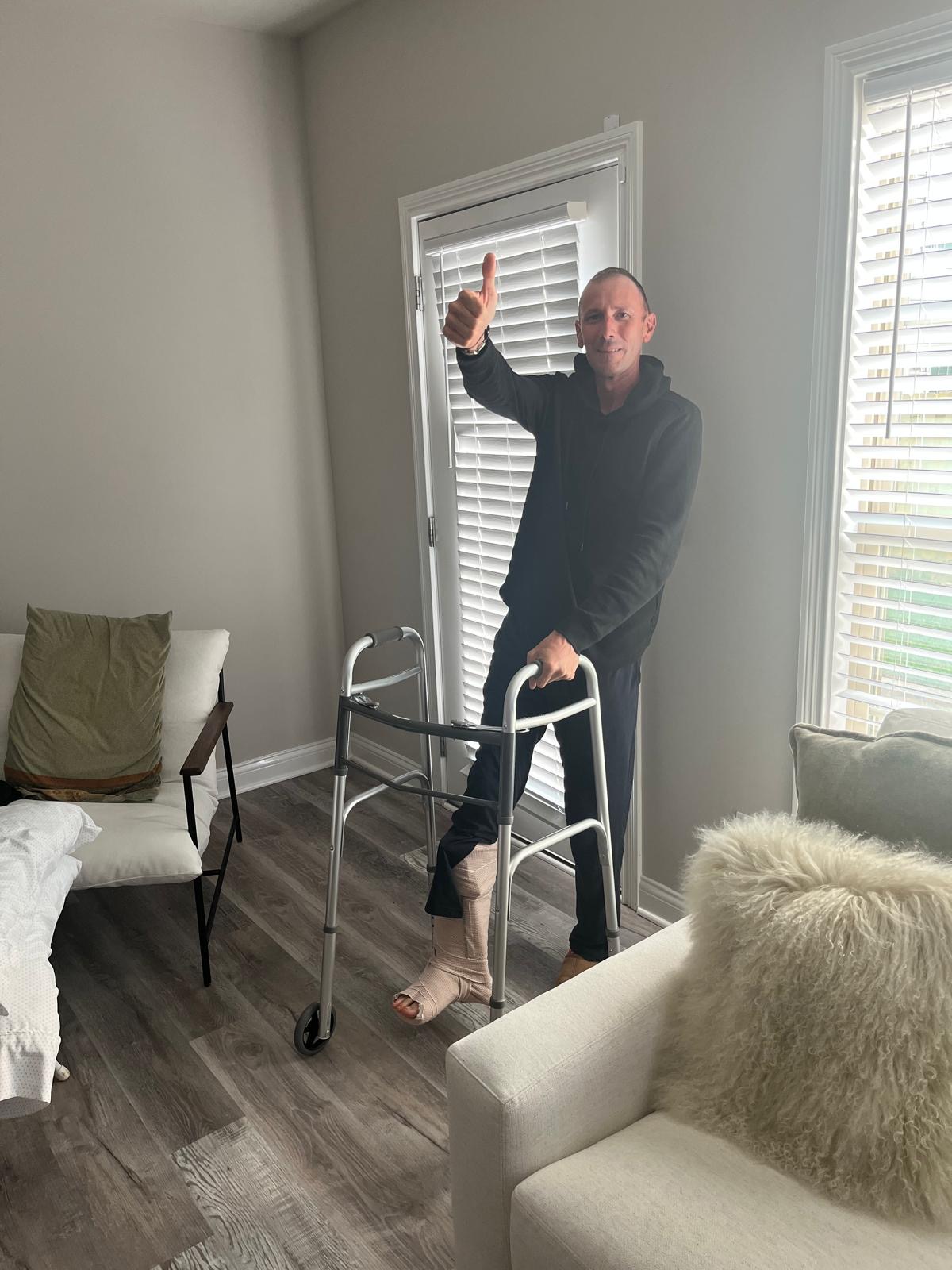
But we knew I would need another surgery, maybe more, and the doctors were considering their next steps. At that point they weren’t sharing too much with me, but eventually they told me they wanted to fuse my ankle, which would have involved putting a rod or plate and screws through the joints.
That would have protected my ankle and given me stability, but would have limited my mobility. For me, that was a terrible option, because I felt it would have been impossible to do my job—to put my heels down, or land after a jump.
I give the doctors credit, because they listened to me, and once they understood what my goal was after rehabilitation, they came up with a different plan.
Essentially, two weeks after my accident, they brought me back into the operating room, and they rebuilt my ankle the best that they could. They secured everything with a titanium plate on both sides of my leg, but they didn’t fuse the joints. The surgery went as planned, and they were happy with it.
But there were still no promises from the doctors at that point.
Everything would depend on whether or not it became infected. And, given how long I’d been down in the warm-up ring, infection was still a major concern. They told me my body’s reaction to the surgery, my own attitude, and how well I took to physical therapy and the rehabilitation process were also factors in how well I would recover.
All those things were true. But, looking back, I believe it was also something else.
I have always tried to be a healthy person, and I consider myself to be, generally speaking, pretty fit and strong. But with something like infection, and who gets it, and who doesn’t, it comes down to luck in those situations, pure and simple. That part is not in your control.
*****
After my second surgery, I basically couldn’t move for a month. I stayed on the couch, and the only place I went was to check-ups every other week with my doctors.
The first phase of rehabilitation I did was called ‘passive rehabilitation,’ meaning the physical therapists would stand at the side of my bed and manipulate my foot and ankle. Everything, at that point, was shut down, and so was the feeling in my ankle. They started, essentially, with one toe at a time.
The whole experience was like I was watching another person’s leg.
My toes weren’t moving when I told them to, and the scary thing was there was no guarantee that I would ever regain feeling in my foot. They told me, best case scenario, I would probably always walk with a limp.
That didn’t really bother me, or even the fact that I couldn’t run again. What I needed to be able to do—for my work and for myself—was to be on a horse.
I’ve always been a perfectionist, and tough on myself, especially when it comes to my riding. My biggest fear, even as I began on the path of recovery, was that I was never going to be the rider that I once was. Back then, even sitting on a horse again seemed so very far away.
That’s what really scared me. If I’m honest, that was one of the darkest times in my recovery.
I would sit there at home, after the physical therapists left, and see my leg not moving when I was telling it to. It definitely put me into a kind of depression. In general, I’m a fighter. But in those moments, I felt like surrendering.
How could I ride again if I couldn’t even move my toes?
I’m so grateful to Nicki and her family, but especially in that period, because I wasn’t at my best and they became my family here in America. They were there for me in every way when I needed them—and that’s a special thing, because it wasn’t the case with everyone.
Some people that I expected to be there for me weren’t, and that was also difficult. Many more people were, though, and I will be forever grateful to them. They gave me the good vibes and the positive support that I needed. Eventually, the clouds lifted, and I started fighting again.

Because the risk of infection was still significant, my doctors wouldn’t allow me to fly down to Wellington, where our winter farm is, until November. When I got down there, I started to increase the PT I was doing, with more weight-bearing exercises on my leg.
In January, I thought I might be ready to sit on a horse again, so I chose one of the client’s mares that I trusted. Her name was Evie, and she’s a big mare, and kind of motherly in a sense—she takes care of you. I felt safe on her and always knew she would be the one I wanted to ride first.
Fair to say, I was not scared at all to mount her, even though that was what I’d been doing when I was hurt. But when I sat down in the saddle and saw how my right leg looked at my side—just sticking out, away from the horse, with no flexion, and no mobility, I had had enough.
I told the people helping me, I was like, “Guys, thank you, but I’m not getting back on a horse for a while. Let me go back to the physiotherapist and we’ll see what we can do.”
I told myself that I was going to table my riding for a time. I didn’t want to get back on a horse until I could make my leg function the way I wanted it to, and the way I still believed that it could. I went back PT for another two months, and I worked harder than ever.
My healthcare team was still treating me very carefully, and they would only increase my exercises when my doctor in Wellington approved it, and only based on how my monthly X-Rays and MRI looked.
One weekend, after I’d had my regular scans, my doctor called me, and I immediately thought, Why is he calling me on a Saturday morning?
I was right to be afraid, because he said my MRI was concerning. He was worried that my ankle bone had stopped healing.
That was a nightmare, because the solution was likely a third surgery, which would put a cadaver bone graft (called an allograft) into my bone to help stimulate it to grow. Not only would it be a third surgery, but it came with an increased risk of infection.
They had me come back into the clinic the next week. My doctor, thankfully, had come up with another solution.
He told me that if I was willing to postpone my riding for a little longer, they could hold off on surgery and we could try a bone stimulator machine, which would use low-level electromagnetic pulses or ultrasound waves to stimulate healing in my bone.
I had to use it every day, but thank God, it worked, and my bone started to regrow.
Throughout my rehabilitation process, I had gone from using a rolling walker to get around, to being on crutches, to then using a cane. Finally, I didn’t need anything to get around with. At that point, I felt like I was ready to try riding again.
I started riding at the walk, and eventually, I began trotting. For almost an entire year, I could only do the sitting trot, because my stirrups had to be set at very different lengths—there was actually a 10-hole difference in the stirrups on my left and injured right sides.
I was also very weak on my right side, because I had lost all my muscle tone. I had to re-learn how to balance in the saddle using other parts of my leg to compensate.
I worked very hard at that, and I had people film me in the saddle so I could study my position. At first, watching those videos was very difficult: it was almost as if I was looking at another man in the saddle. I didn’t recognize myself, and that was so frustrating.
For me, this is my job—and I am very lucky that it is my job—but riding is so much more than that to me. It’s my passion and my life. The horses are a kind of sickness for me, in the best sense. I can’t be without them. But during my rehabilitation, that was always a double-edged sword.
When I could finally be back at the shows with my team, I would sit there in the middle of the ring, and watch other people riding, and help to coach, and I would be happy. But then, I would also be thinking, Is this as far as I will go? Can I walk a course again with my students? Can I ride their horses again?
Before the accident, I hadn’t spent a lot of time in hospitals or rehab centers. But in those moments, when I was struggling, I made myself pay attention to the other people there. I realized that yes, I was dealing with something major, but there were so many others out there struggling with injuries and illnesses that were far worse than mine.
When I would go to the hospital for my follow-up checkups, or to my PT appointments, and I would feel sorry about my situation, I would focus on that aspect, and what I was still able to do. That put me in a better headspace, and it made me want to work even harder.
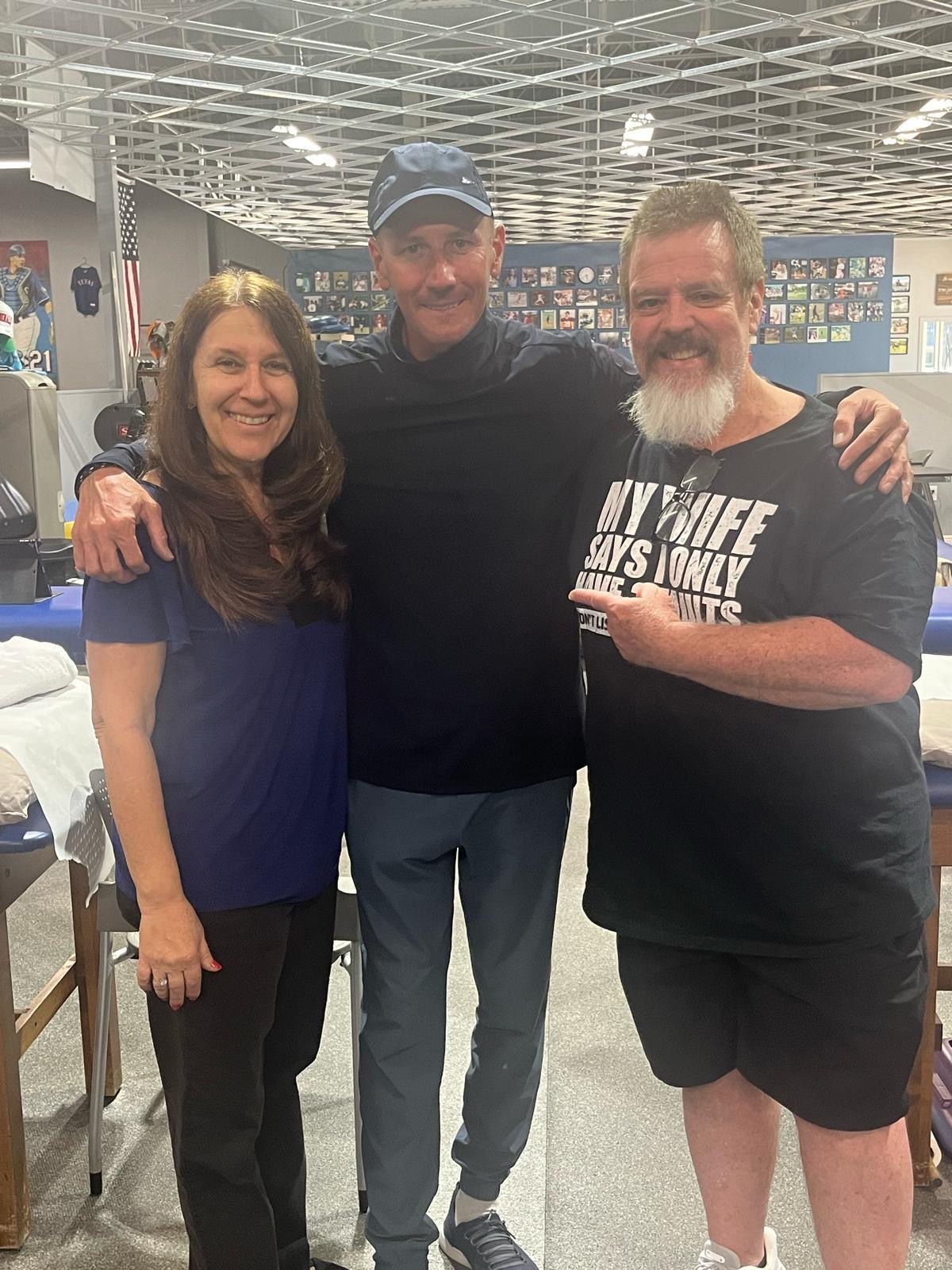
Because of the hardware in my leg, and relearning to walk on my new ankle, my doctors had to constantly check my leg for straightness. I still have monthly video calls with my PT team in Wellington so they can monitor it, and I’ll film myself riding regularly, to make sure my leg is straight, and in the correct position on the horse.
When I ride, I still don’t have full flexion in my right ankle. I can’t—as the up-down trainers always tell you—put my “heels down, toes up.” I will always have to get off on a mounting block, instead of dropping to the ground, since my doctors want me to be very careful about landing on my right leg.
That’s also the reason I have to be thoughtful about the horses that I ride, and how fresh they are. It’s not because I can’t ride through what they might do when I’m up there. The worry is that, if I ever had to jump off quickly, for any reason, I can’t land on my right leg.
I also like to joke that my dream of being a runner is over. But all that being said, there are worse prices to pay.
Today, if you didn’t know I’d had the injury, and you see me on a horse, you probably wouldn’t be able to tell. It took me a while, but I can once again walk the strides on course with our riders before a class. And, as of the last few months, I can finally post the canter again.
It took 800 days. I counted.
From the day I fell off to this September, it was 800 days until I was able to work my horses again in the posting canter. That had been a goal of mine for a long time, but I wasn’t strong enough. Now that I can do that, I would say I’m about 90 percent back to where I want to be.
That’s pretty amazing when you realize where I started.
When I run across stewards, riders, and trainers at horse shows—people who were at the Kentucky Horse Park that day—they can’t believe that someone could recover from an injury like mine. They tell me, “You’re a miracle!”
I don’t know if that’s true. But I know that if it was not for the people who stood by me, for Nicki and her family, who supported me—and kicked my butt when I needed that, too—I would not be where I am now.
I am thankful that I could wake up in the morning every day and feel lucky, because I still had the horses, and I still had the hope that I could someday get back to them. That was a gift.
What to read next: “Talk Less, Observe More: Simone Besutti Is a Horse’s Horseman”
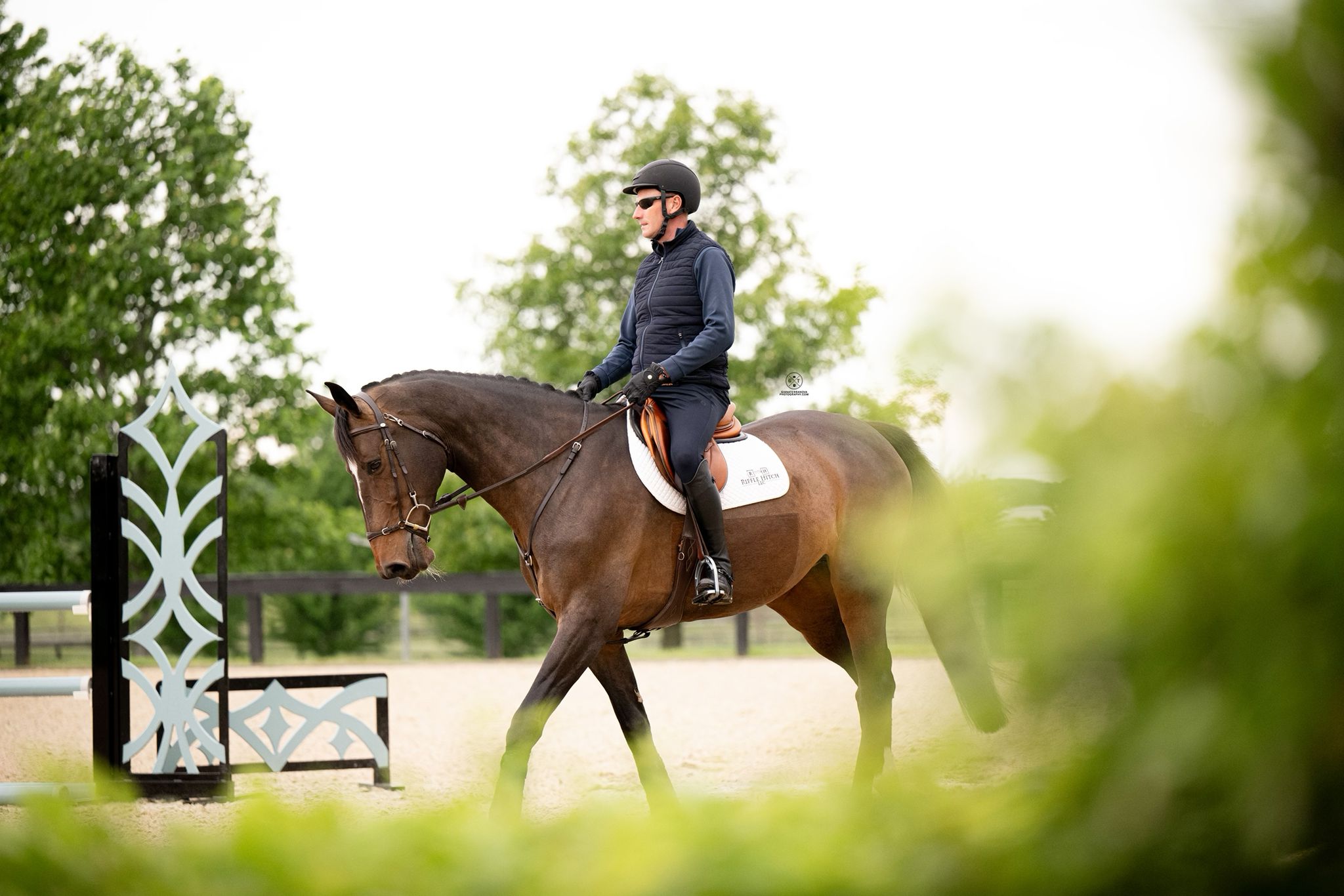

 November 19, 2025
November 19, 2025 





